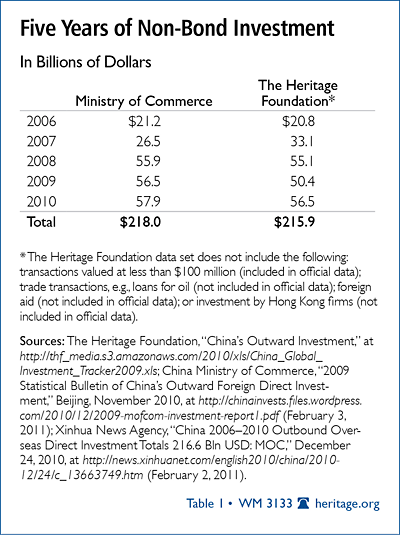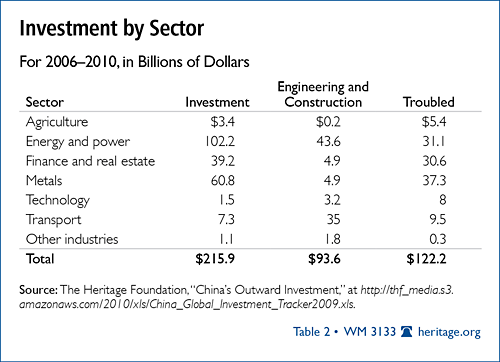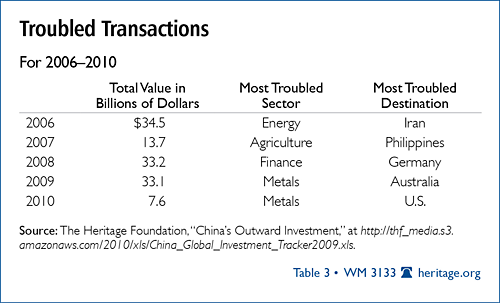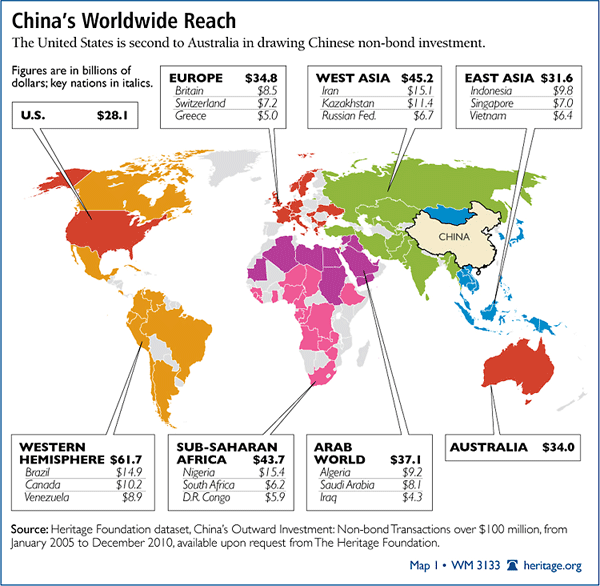Everyone complains about the weather, but no one does anything about it. Everyone complains about poor information coming out of China—even senior Chinese officials—but no one does anything about it. Almost no one.
The Heritage Foundation’s China Global Investment Tracker documents large Chinese investment overseas outside of bonds. The volume of this investment has exceeded $200 billion in the past five years. The tracker also contains information on nearly $100 billion in large construction contracts since 2005. These numbers will only rise as China seeks to find outlets for closing on $3 trillion in official foreign exchange reserves.
Where Chinese Money Is Going
The dominant aspect of Chinese investment in 2010 was a rush to South America, led by (but not limited to) Brazil. Other features include a jump in new, large construction contracts and fewer failed transactions. Chinese investment in the U.S. in 2010 was steady at a bit over $6 billion but far more diversified than in 2009. American policy concerning this investment is inconsistent and opaque and should be improved.
Amounts. In 2010, Chinese non-bond investment maintained its steady performance of the past few years, holding above $50 billion annually despite the impact of the financial crisis. On the Heritage tally, investment saw a 12 percent increase last year and is likely to increase by a similar amount again in 2011. In addition, the value of the large construction contracts tracked by Heritage reached a new high at over $30 billion.

The Heritage series excludes investments of less than $100 million but nonetheless is a close match to official Chinese data. This suggests that large transactions now dominate Chinese spending. A related feature in both Heritage and official Chinese data is the preeminence of large, centrally controlled state entities as investors.
Countries. The Heritage series is far more useful than Chinese data in determining what country destinations are ascendant. The Ministry of Commerce did not publish its breakdown of 2009 investment until November 2010. Even then, Hong Kong accounted for 63 percent of outbound investment because the PRC treats Hong Kong as a separate customs territory. In fact, investment passes through Hong Kong heading elsewhere. The Heritage series tracks spending to its final destination.
The main event in 2010 was a flood of money into the Western Hemisphere outside the U.S., led by Brazil but also featuring Canada, Argentina, and Ecuador. Almost an afterthought in 2008, this is now the leading area for Chinese spending. Brazil is the third-largest target for Chinese investment, trailing only Australia and the U.S., though Nigeria and Iran also boast large engineering contracts.
A word of caution: A previous rush into sub-Saharan Africa saw promised investments and contracts that did not materialize. To some extent, this will happen in South America as well.
Perhaps surprisingly, Chinese non-bond investment in the U.S. fell slightly in 2010. Nonetheless, last year was far healthier and more sustainable than 2009, when spending was dominated by sovereign wealth fund China Investment Corporation’s purchases of distressed financial assets. In 2010, a panoply of firms invested in a range of sectors, including the first large resource investment by once-spurned China National Off-Shore Oil Corporation. Last year was a solid foundation for Chinese investment to raise its abysmal performance relative to American GDP.
Sectors. As with the geographic breakdown, official Chinese sector data are late and not useful, featuring opaque categories that cut across conventional industries, such as “business and leasing services.” It is no surprise that energy and power draw the most funding and that 2010 closed with a rush of energy acquisition and plant construction deals.
Metals draw the second-most investment, followed by finance and real estate. The other sector of particular importance is transportation, which sees only minor investment but a great deal of engineering and construction contracts, such as rail lines. It is worth noting that the PRC’s established desire to acquire assets in agriculture and technology has been stymied almost completely up to this point.

Problems. Two sets of errors plague Chinese investment: bad information and bad execution. The information problem is usually not the fault of the PRC. Host countries boast of and the media breathlessly report investments that might never occur (such as in Nigeria) or huge but largely unused loan facilities (such as in Venezuela). Legitimate transactions are reannounced again and again. Companies seeking higher bids from suitors advertise tenuous Chinese involvement.
More fundamental, trade and loan figures are often mixed with investment, though neither is nearly as valuable dollar for dollar. Loans do not bring ownership, and trade involves only a contemporary transaction with no future income. The tracker measures only Chinese investment, not the less important trade and lending deals.
In terms of executing investment, Chinese firms have clearly learned, completing more transactions and suffering fewer problems of their own making. The tracker includes “troubled transactions”—those rejected at a late stage by regulators or those that partly or entirely fell apart. Initially, most troubled transactions involved energy; now metals appear to be more challenging. The countries drawing the heaviest interest—Australia, the U.S., Iran, and Nigeria—also see the most troubled transactions. Including the Unocal deal blocked in 2005, the U.S. could have received twice as much Chinese investment if deals had not faced various obstacles.

Recommendation: Transparency and Trade
The American reaction to expanding Chinese investment has been to fret, and the rush into South America will induce more fretting. Yet the U.S. has the means both to benefit from Chinese investment and to neutralize any unwanted foreign policy impact.
On the foreign policy side, the U.S. government cannot simply order companies to spend more overseas, as China can. However, it can encourage a more attractive investment environment. The obvious means to do this is bilateral agreements, such as the free trade agreement with Colombia. Free trade agreements are signals of openness in partner economies that draw American companies. Agreements specifically promoting investment are also desirable with some countries.
At home, the U.S. can draw desirable Chinese spending by increasing transparency. The U.S. has gigantic quantities of coal and natural gas but sends mixed signals on permitting Chinese investment in resources. Similarly, clarifying areas of manufacturing that are open to the PRC would immediately result in Chinese investment in permitted sectors.
The ideal way to increase transparency is to sharpen the mandate of the Committee on Foreign Investment in the United States, which has the institutional experience to respond properly to evolving Chinese economic activity in the U.S. It, not Congress or other executive agencies, should be at the heart of the review process.
The Right Response
Chinese outward investment is steadily and unavoidably expanding. American policy should improve in response.
Derek Scissors, Ph.D., is Research Fellow in Asia Economic Policy in the Asian Studies Center at The Heritage Foundation.



